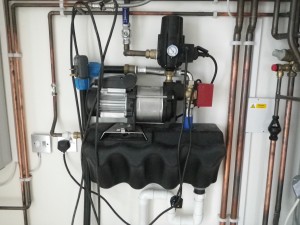The Government has, as of Monday 28th January, announced one of its flagship policies, the Green Deal, in which it hopes thousands of homes and businesses up and down the country will carry out substantial works to their home in order to increase energy efficiency, and cut down bills.
The reason home and business owners may do this is that the Government is offering loans to those who do, which can be paid off through their energy bills over a period of up to 25 years. Approved improvements number 45 in total, including new boilers, solar panels, insulation, double-glazing, draught proofing and wind turbines.
Under the central idea of a ‘golden rule’, the improvements will always reduce energy bills by more than the additions of the loan repayments, making sure that no person or business taking up such a loan will be paying back more than they save. Qualified assessors will inspect the property before recommending improvements that would be worthwhile, hopefully ensuring that this ‘golden rule’ is upheld in all cases.

Although evidently well-meaning, the policy has hit problems before it even formally came into existence. Around the middle of January, it was announced by the Department of Energy and Climate change itself that only five people have registered to show they have been assessed and are ready to take out a loan. That is despite 600 trained and accredited builders and 40 organisations, including B&Q and British gas, all on standby ready to start working on the expected deluge of applicants.
The reasons for this are inherent in the Deals themselves. For one, the loans are actually for the property, forming a type of legal mortgage that must be noted as a charge (usually a second charge for mortgaged homes) on the Charges Register for the property. In not tying the loan to the person, the charges will pass on with the property to any new owner; causing potential problems in conveyances that could both reduce the equity of the seller and put many potential purchasers off.
The interest rates of these fees have also been found to be quite substantially higher than what the same finance could be procured at through the banks if available. Current figures indicate an interest rate of between 7-8% at the moment, well above the 2-5% being offered by banks for a secured legal mortgage.
Proponents have indicated that crucial differences exist between the two though: a Green Deal loan is actually ‘unsecured’ and although 7-8% may seem high, it is comparable with high street rates for long-term ‘unsecured’ loans – which offer the lenders less protection on default.
The Green Deal Finance Company has recently revealed that, whilst these high street loans are typically available only to around 50% of the population, they will be lending to over 80% under a policy of inclusion that hopes to help the worst off as well as the equity rich. As the loans are paid off through savings to energy bills, which are assessed in the initial inspection, the risk to the lender is low, which allows them to offer the finance to a wider demographic.
Despite potentially being able to procure the same loans at cheaper interest rates from a bank, therefore, more may still utilise the Green Deal; particularly those who would typically struggle to procure more funds from their bank.
Further problems with the policy have been highlighted though, including issues around the accrediting of traders. The Federation of Master Builders, which represents over 10,000 small tradesmen and companies, has reported that just one of their members is accredited by the scheme to carry out this sort of works (out of the 600 we noted earlier).
A significant amount of homeowners develop a relationship with local tradesmen whom they know and can rely on. With such a scheme as the Green deal, these homeowners will not be able to use their typical builders and work will instead go to larger companies and corporations. For many people who are keen to support local businesses and traders, this will be a deal breaker.
Perhaps the biggest cause of the extremely low take up so far, however, can be attributed to the poor communications campaign that is only now beginning to take shape. A USwitch survey, published on 23 Jan 2013, showed that even so close to the launch date four out of five people asked had no idea what the ‘Green Deal’ was.
The communications campaign is now bound to pick up pace, however, and the same survey did highlight that 86% of respondents saw lower energy bills as a key benefit, with 70% wanting to make their homes more energy efficient.
Perhaps, then, as the Green Deal develops and the Government begins to communicate more effectively with its key demographic, more will take up the offer. With the Government targeting the upgrade of 14 million homes during this campaign, however, just five takers is not an encouraging start.
—
If you are interested in making use of the Green Deal, more information and a route to application is available here.
[contact-form][contact-field label=’Email’ type=’email’ required=’1’/][contact-field label=’I liked this article’ type=’checkbox’/][contact-field label=’I did not like this article’ type=’checkbox’/][contact-field label=’Comment’ type=’textarea’/][/contact-form]

